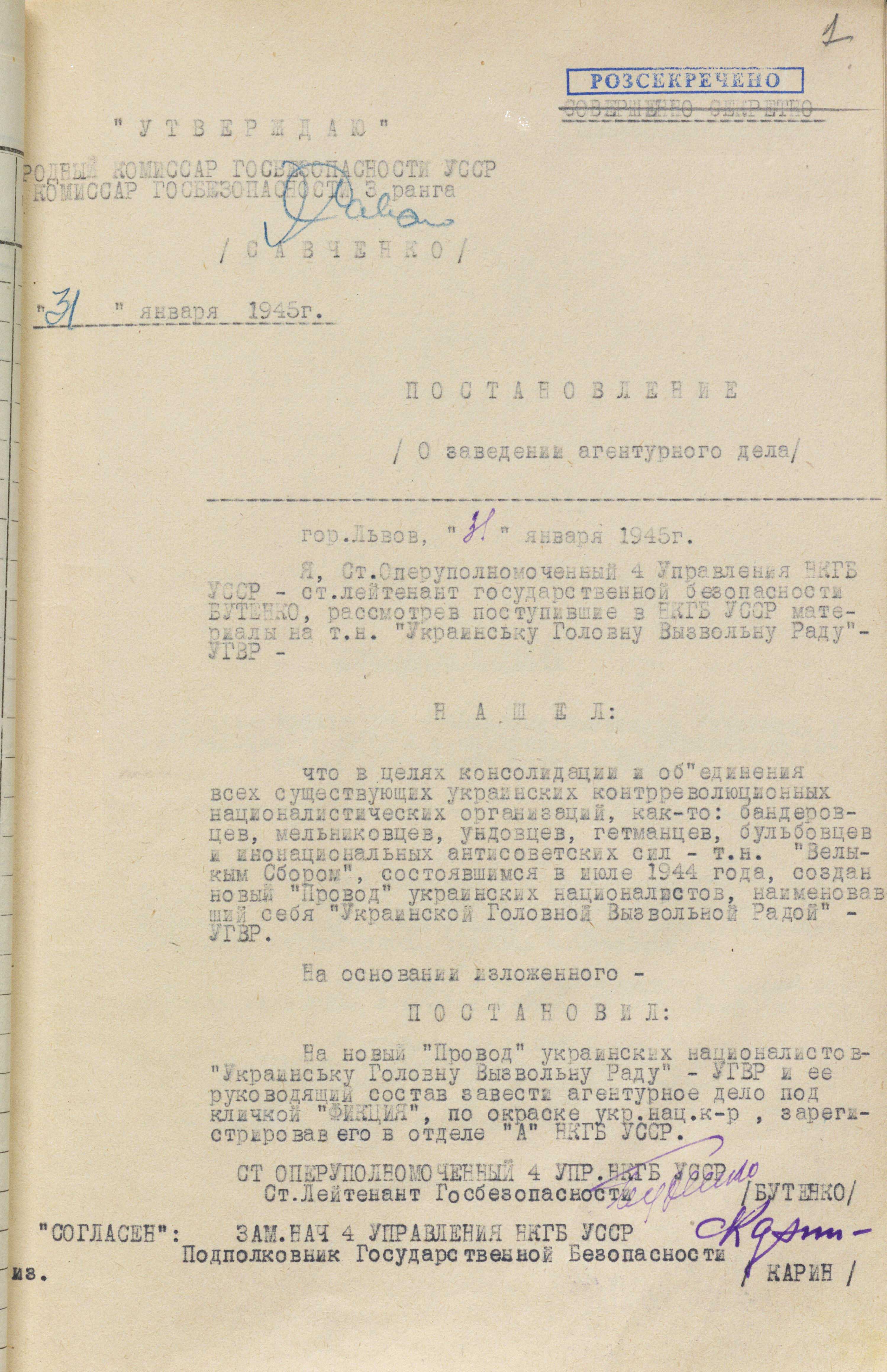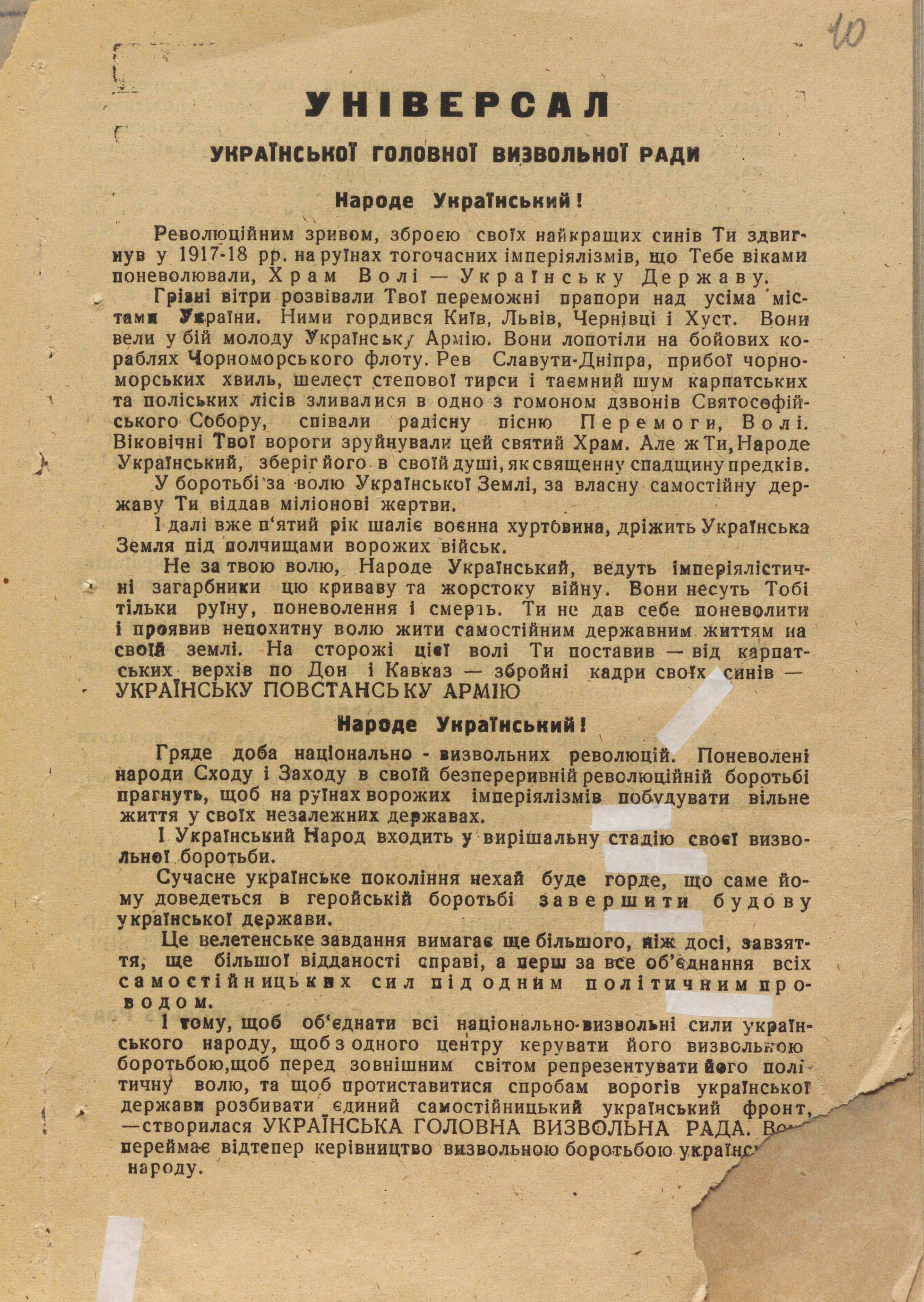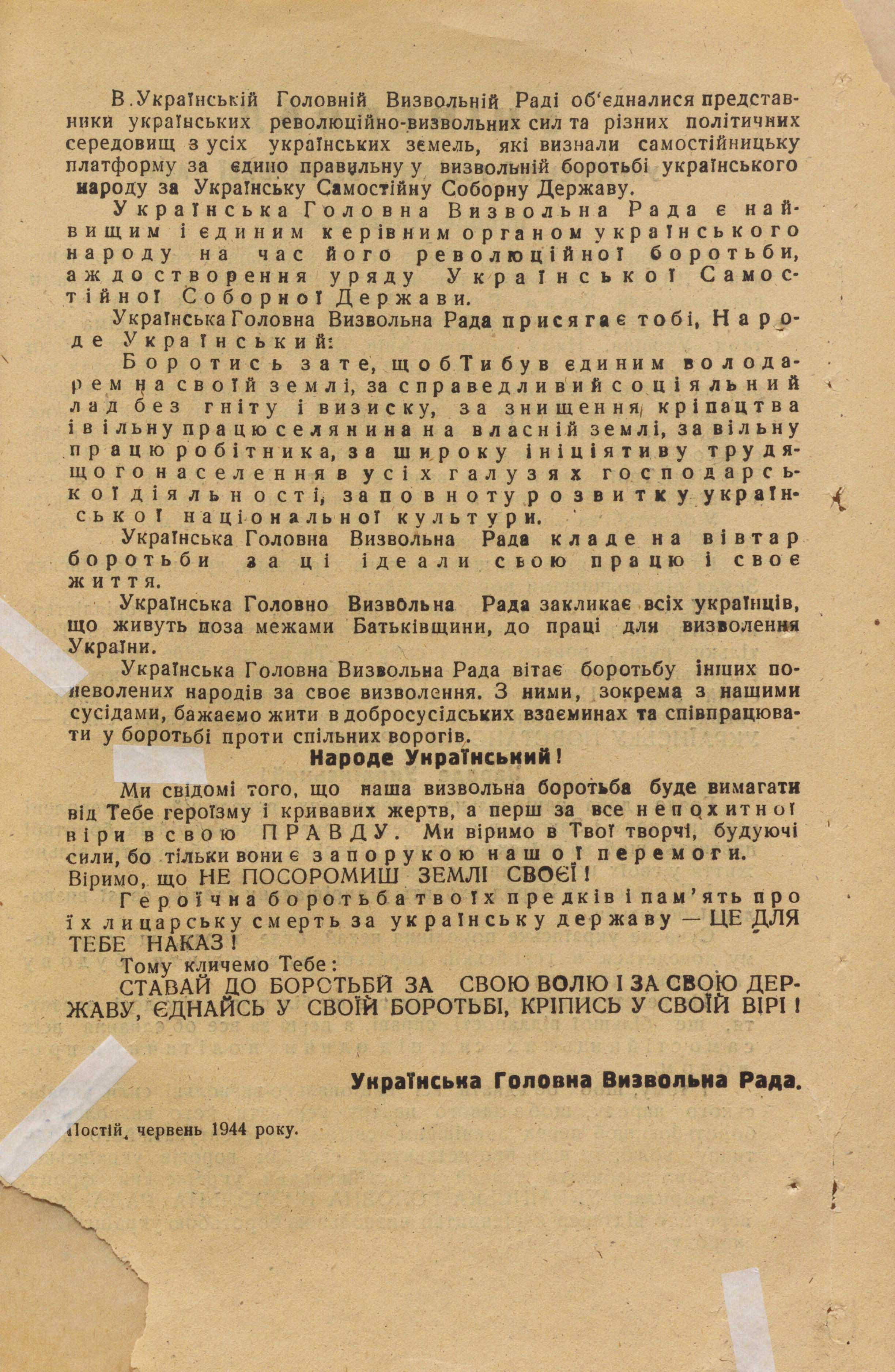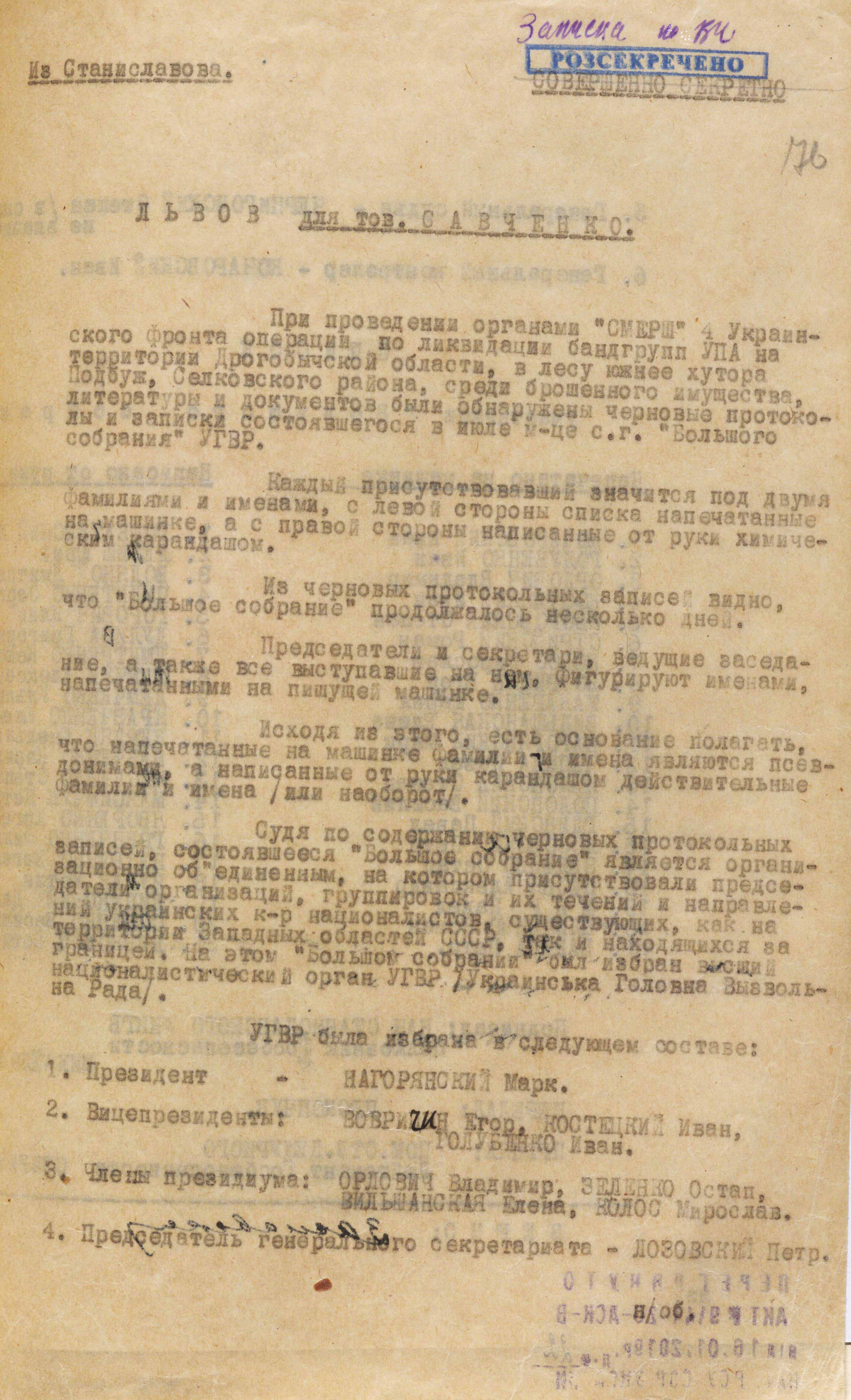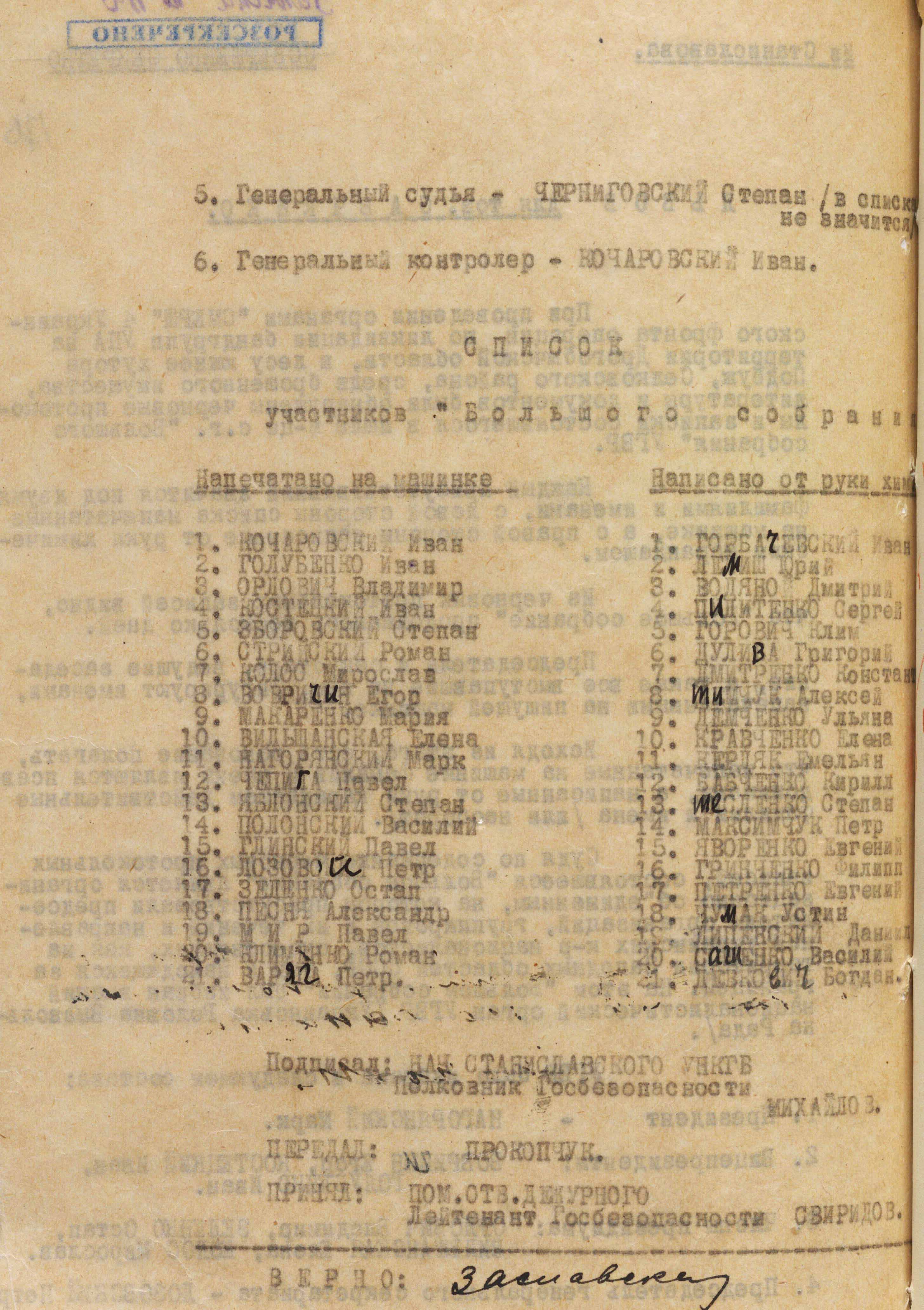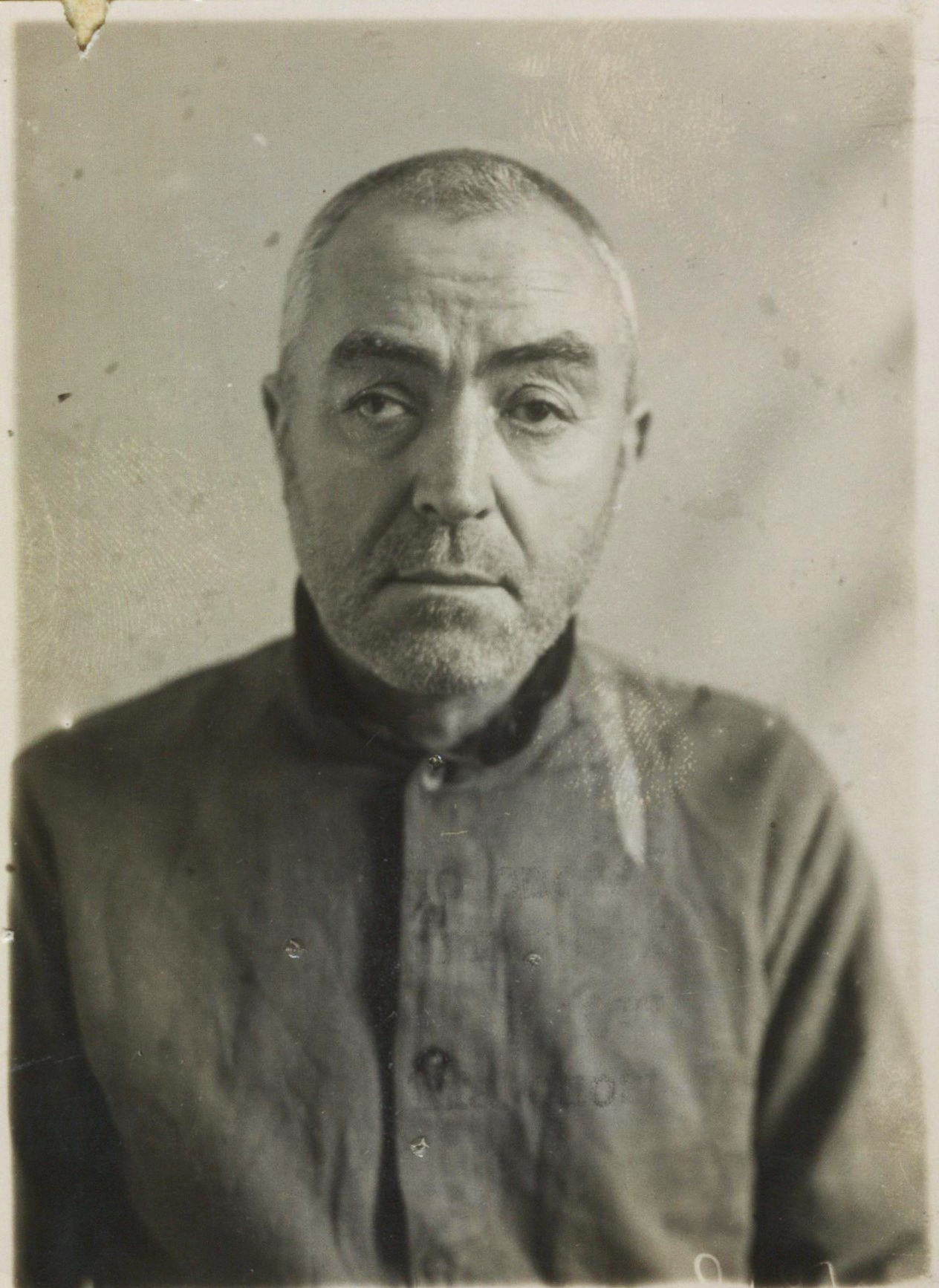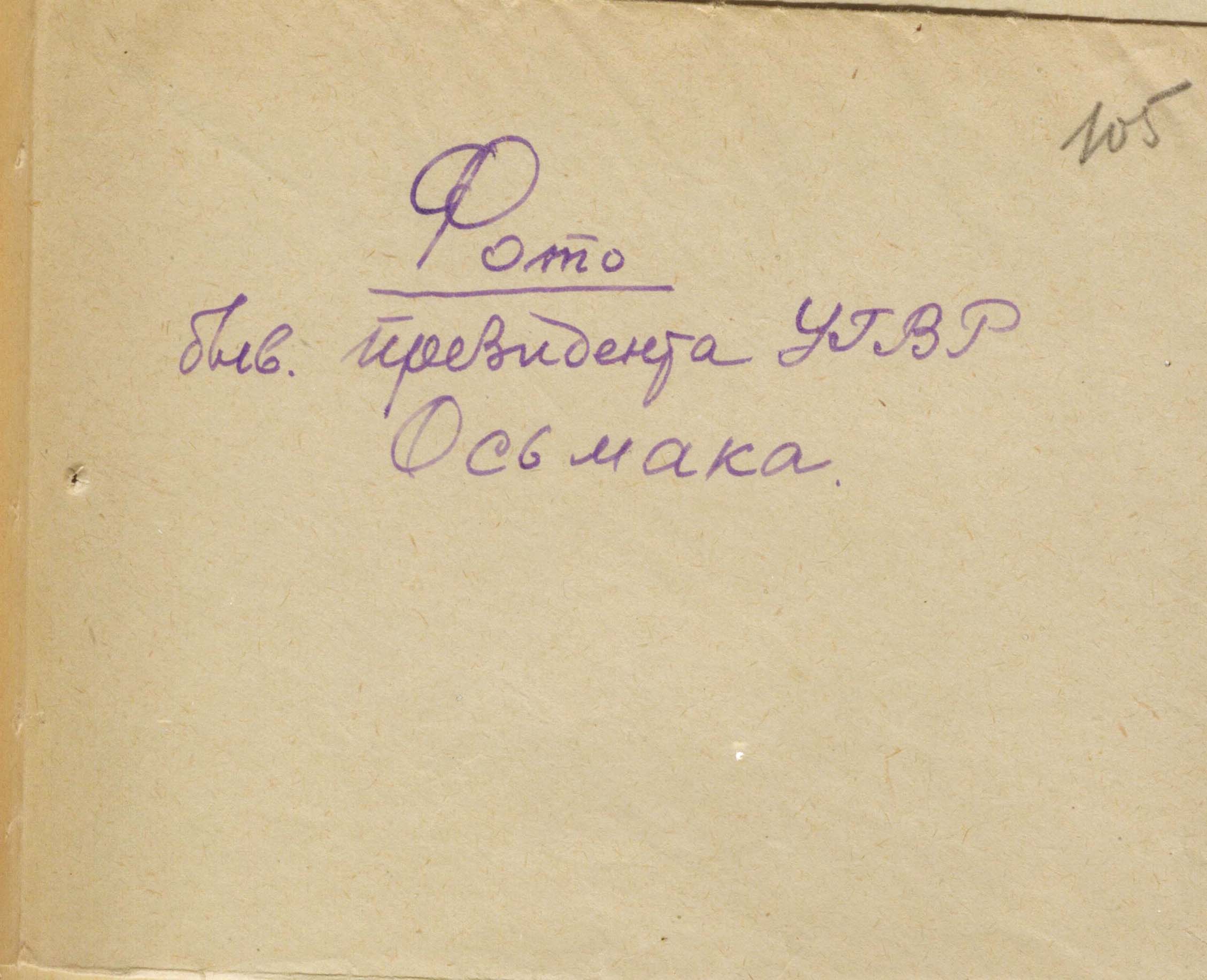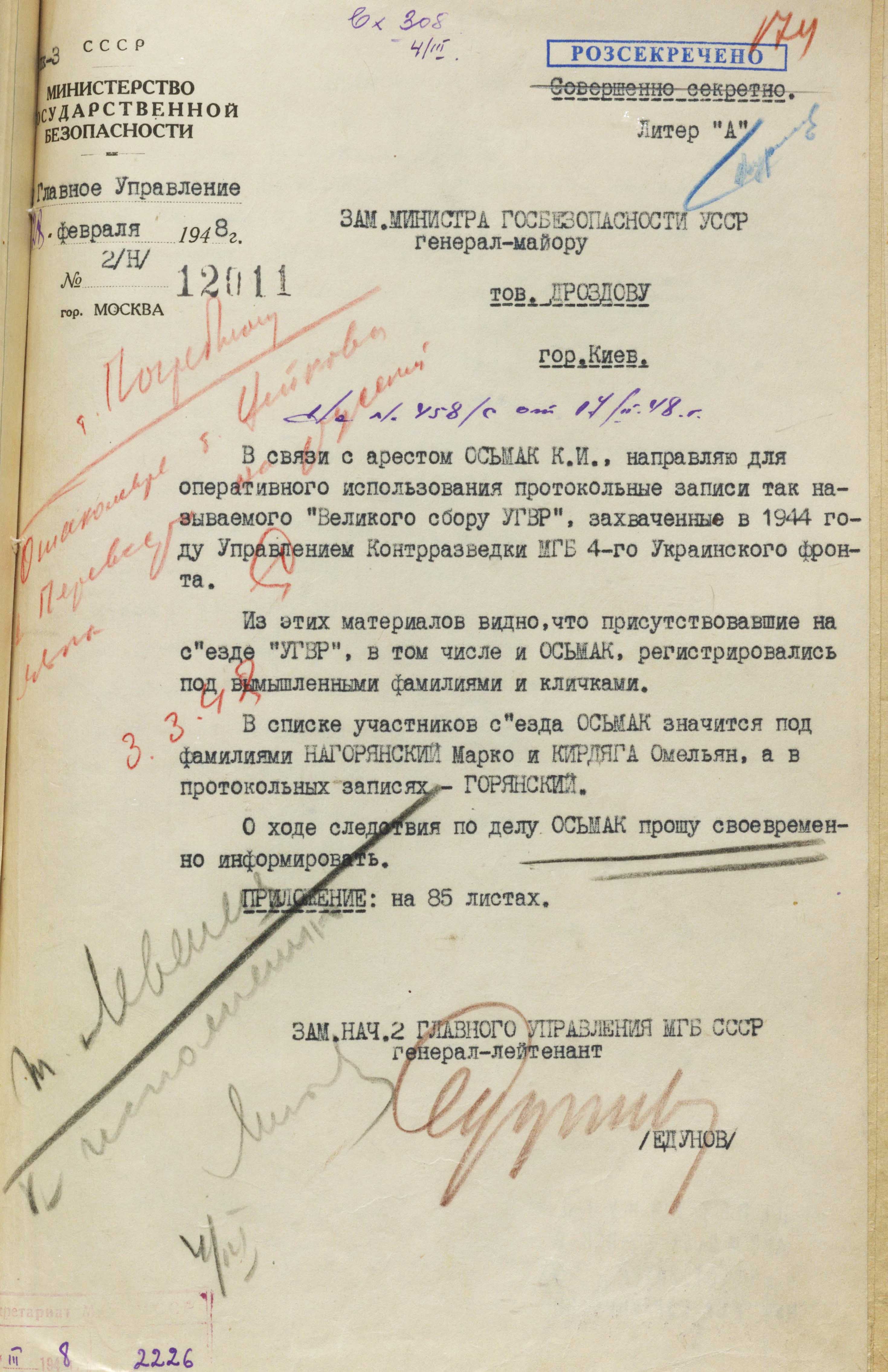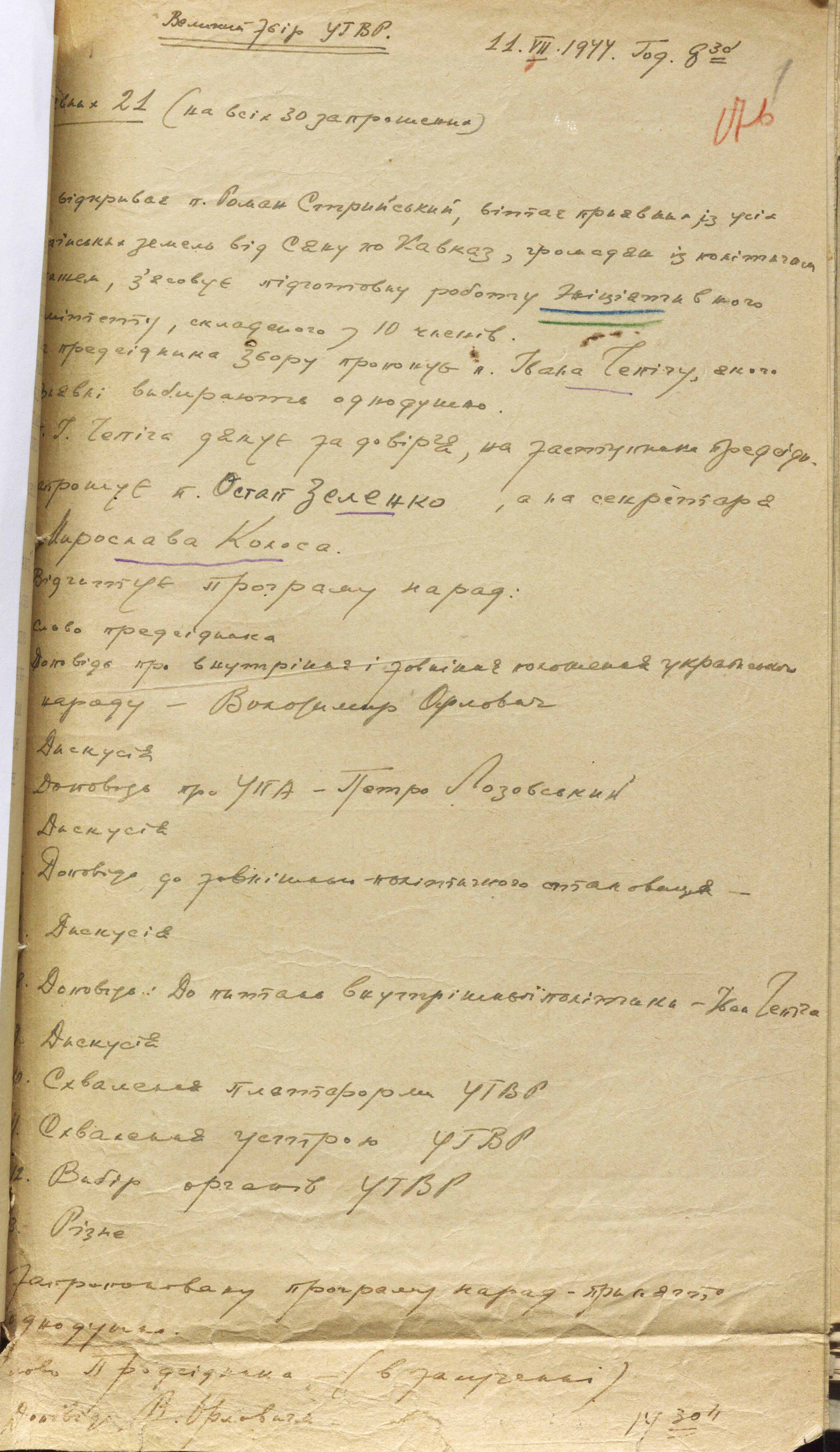Ukrainian Supreme Liberation Council. Secret Records
7/11/2024
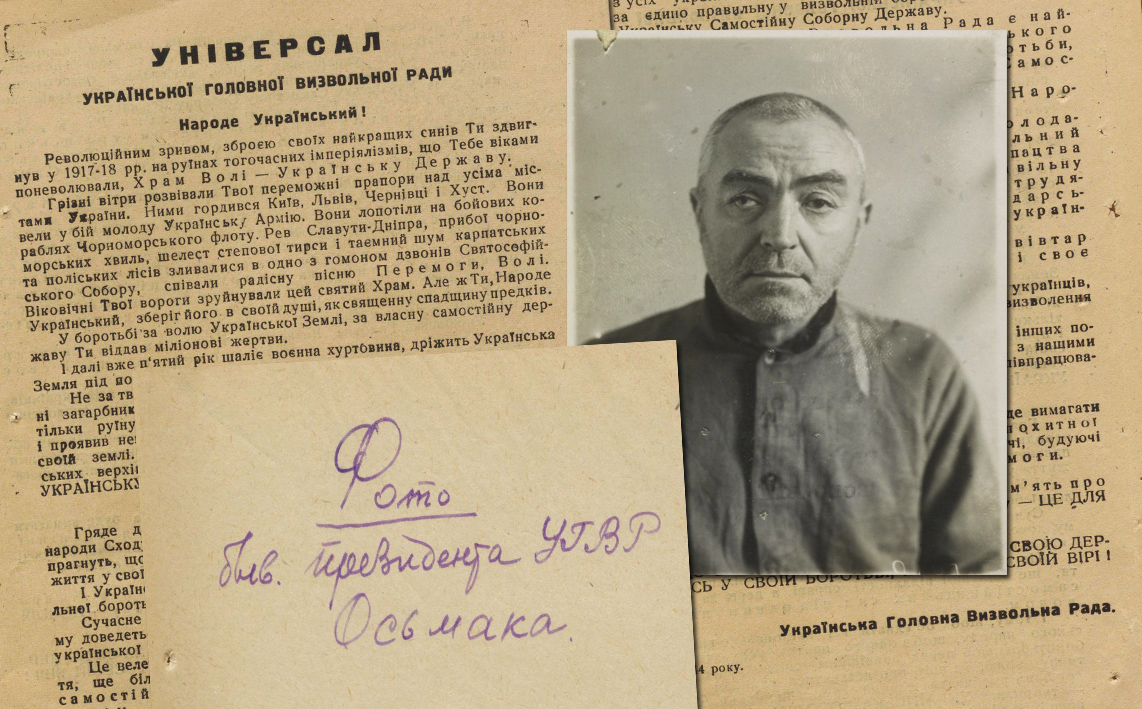
80 years ago (July 11-15, 1944), under conditions of strict secrecy, the Ukrainian Supreme Liberation Council (UHVR) was proclaimed at a constituent assembly in the foothills of the Carpathians in Lviv region. According to declassified documents from the archives of the Foreign Intelligence Service of Ukraine, stalin's special services learnt about the creation of this insurgent provisional Parliament or Government of the warring Ukraine only at the end of 1944. Then, as a result of one of the special operations, the chekists got hold of the minutes of the first meeting of the UHVR. Yet for quite a while longer, the nkgb could not find out the real names of the participants in that first Grand Assembly, which were deliberately changed in the document.
The Underground Government of the Warring Ukraine
In November 1944, a message was sent from Stanislaviv (now Ivano-Frankivsk) to the people's commissar for state security of the Ukrainian ssr Serhiy Savchenko via HF communication, which forced all agents to seek information about the new organizational structure of the Ukrainian underground movement – Ukrainian Supreme Liberation Council and its members. But the task was not easy. Months passed, but it was not possible to identify those behind the abbreviation UHVR. And this was despite the fact that the chekists got hold of a list of the new structure's leaders. But all the names on it were unfamiliar. It took several years to solve this puzzle.
The note on HF communication stated that during an operation by the SMERSH of the 4th Ukrainian Front to eliminate UPA units in Drohobych region in the forest south of the village of Pidbuzh, among the abandoned property, books, and documents, draft minutes and notes of the Grand Assembly of the UHVR held in July 1944 were found. In them, each person present was listed under two surnames and names. On the left side of the sheet, the list was made on a typewriter, while on the right side, by hand with a chemical pencil. The document suggested that “the names and surnames printed on the typewriter are pseudonyms, while the handwritten ones in pencil are real names and surnames (or vice versa)”.
“It follows from the content of the draft records”, the report said, “that the “Grand Assembly” is an organizationally united one, attended by the heads of organizations, groups and their wings and branches of Ukrainian counter-revolutionary nationalists, which exist both in western regions of the ussr and abroad. This “Grand Assembly” elected the supreme nationalist body, the UHVR (Ukrainian Supreme Liberation Council).
The UHVR was elected in the following composition:
1. President – Marko Nahoryanskyi.
2. Vice Presidents: Yehor Vovrychyn, Ivan Kostetskyi, Ivan Holubenko.
3. Members of the Presidium: Volodymyr Orlovych, Ostap Zelenko, Olena Vilshanska, Myroslav Kolos.
4. Head of the General Secretariat: Petro Lozovskyi.
5. General Judge – Stepan Chernihivskyi (not listed).
6. General Controller - Ivan Kocharovskyi”
(BSA of the SZR of Ukraine. - F.1. - Case 11780. - Vol. 1. - P. 76).
According to archival documents, the nkgb immediately sent information about the new organization to moscow. A letter that soon came from moscow to Kyiv shows that the central office of the nkgb had no information about the UHVR from either domestic or foreign agents. This is one of those rare cases in the history of the Ukrainian national liberation movement when such an important event was organized in the most secretive and conspiratorial manner. Moreover, the careful selection of the participants and those who ensured the organization and security of this event indicates the complete absence of the nkgb operational sources in their ranks.
Thus, faced with a lack of necessary information, deputy people's commissar for state security of the ussr Bohdan Kobulov set a task to clarify the following questions:
“...What does the creation of the UHVR mean – is it an organizational union of all Ukrainian nationalist organizations or is it just about contact between them while maintaining the organizational independence of each? This question is of utmost importance...
Who are the members of the UHVR? No members of the UHVR you mentioned are known to the nkgb or registered with us.
What is known about the location of the UHVR?”
(BSA of the SZR of Ukraine. - F.1. - Case 11780. - Vol. 1. - P. 109).
It is noteworthy that six months after receiving this document, in May 1945, Kyiv reported to moscow that it had not yet been possible to detect any practical activities of the UHVR on the territory of Ukraine, with the exception of the distribution of the “Universal” and the “Platform of the UHVR”. They also reported that the participants of the “Grand Assembly” and the UHVR leaders elected at that meeting remain unknown. Therefore, they wrote that they considered infiltration of agents into this organization and its operational cultivation to be relevant and necessary. The nkgb gave the cultivation the codename “Fiktsia”, thus outlining their attitude to the new organization.
Meanwhile, the Ukrainian Supreme Liberation Council continued its activities in deep secrecy. Contrary to the nkgb's previous conclusions, the UHVR was not a new political organization, but a structure designed to coordinate existing parties and movements to fight for Ukrainian statehood, a kind of political leadership body for the Ukrainian liberation movement.
The decision to create a broad political organization to which the UPA would be subordinate was made in March 1944 at a meeting of the Provid of the OUN held in the village of Soroky near Lviv. An initiative committee was set up to develop program documents and prepare for the Grand Assembly. In June, the “Universal” and the “Platform of the UHVR” were written and published. Copies of the documents have been found in the archives of the Foreign Intelligence Service of Ukraine.
The text of the “Universal” is addressed to the Ukrainian people. It points out: “And again, for the fifth year in a row, the war storm is raging and like lava is rolling through the Ukrainian lands. The Ukrainian land is shaking under the hordes of enemy troops. It is not for your freedom, Ukrainian people, that the imperialist invaders are waging this bloody and cruel war. They bring you only destruction, enslavement and death. You did not allow yourself to be enslaved and showed an unwavering will to live an independent state life on your own land. To guard this will, You have placed – from the Carpathian peaks to the Don and the Caucasus – the armed cadres of Your sons – the Ukrainian Insurgent Army”.
And it goes on to state: “And so, in order to unite all the national liberation forces of the Ukrainian people, to lead our liberation struggle from one center, to represent their political will to the outside world, and to oppose the attempts of the enemies of the Ukrainian state to break up a single independent Ukrainian front, the Ukrainian Supreme Liberation Council was created. It now takes over the leadership of the liberation struggle of the Ukrainian people”.
The text also reads that the UHVR is the highest governing body of the Ukrainian people for the duration of the revolutionary struggle, until the establishment of the Government of the Ukrainian Independent State; that it brings together representatives of all active revolutionary and liberation forces of modern Ukraine; and that the struggle of other enslaved peoples for their liberation is also welcomed.
The “Platform of the UHVR” emphasizes the need to “a) defend the Ukrainian people and their leading cadres from physical destruction in the midst of the current total war; b) lead the people to fight for their liberation and their own sovereign state”. And to accomplish these tasks, the authors believe, a single all-Ukrainian national front is needed, organized on the basis of the unification of all national Ukrainian forces that seek a Ukrainian sovereign state.
The grabbed by the nkgb minutes of the constituent meeting of the UHVR, which took place from July 11 to 15, 1944, in the forest near the villages of Nedilna and Sprynia in Sambir district and at which the creation of this structure was proclaimed, describe how the main issues were discussed, what discussions took place, and who defended what position. The only thing was that for a long time the chekists could not understand who exactly was behind those unknown names.
Today, it is known from some open sources and memoirs that 20 people took part in that meeting (5 more agreed to accept the mandates but could not attend in person). Instead, the minutes and notes seized by the chekists mention 21 people (out of 30 invited). The list survived, but it contains only pseudonyms. The minutes begin with the approval of the agenda. Ivan Chepiha was unanimously elected Chairman of the Presidium of the Grand Assembly. This pseudonym was used by Rostyslav Voloshyn, the Deputy Commander-in-Chief of the UPA, who also presided over the Third Extraordinary Grand Assembly of the OUN (1943). On the first day, a report on the internal and external situation of the Ukrainian people was to be made by Volodymyr Orlovych (pseudonym of Myroslav Prokop, a member of the OUN Provid and a member of the initiative committee for the creation of the UHVR). The report on the UPA was made by Petro Lozovskyi, known under this and a number of other pseudonyms, the UPA's Commander - in-Chief Roman Shukhevych.
According to the minutes, discussions about the status, fundamental principles of the UHVR, and tasks for the near future and beyond continued for five days. The meeting was aimed at creating a broad socio-political base for the struggle against German Nazism and russian bolshevism for Ukraine's state independence. The UHVR adopted democratic principles of state and political life and a socio-economic program for the future structure of Ukraine.
The underground Parliament (also called the Pre-Parliament) included representatives of the OUN, former members of the Central Rada, Hetmanites, leaders of the Ukrainian National Democratic Union (UNDO), the largest Ukrainian parliamentary force in the interwar Polish Sejm, and representatives of church. Among the members of the UHVR were not only representatives of Western Ukraine, but delegates from eastern region as well. This showed that the UPA represented the interests of the entire Ukrainian people. This was the intention.
In his closing speech, Rostyslav Voloshyn, who presided, emphasized as follows:
“The work of the Grand Assembly was not easy, but everyone had a good will to serve a good cause with all their might... Before the UHVR, everyone took on the task of fighting for the USSD (Ukrainian Self-Determined Union State) and will fulfill it as best he can. We may have to be far away from each other, but we will all remember these moments when we took on a great responsibility in the forest, and we must call on everyone to follow us. We will survive more than one trial and have full satisfaction that today our people already believe in their truth and are ready to die for it and not only...”(BSA of the SZR of Ukraine. - F.1. - Case 11780. - V.2. - P. 259-260).
On the final day of the work, the UHVR leadership was elected. Kyrylo Osmak, a former member of the Central Rada, was elected President. Vasyl Mudryi, Ivan Hryniokh, and Ivan Vovchuk were elected Vice Presidents. The Government (General Secretariat) was headed by Roman Shukhevych, who also became Secretary General of Military Affairs. Rostyslav Voloshyn was appointed Secretary General of Internal Affairs, and Mykola Lebed was appointed Secretary General of Foreign Affairs. Yaroslav Bilenkyi became the General Judge. Daria Rebet-Tsisyk (pseudonyms “Orlyan”, “Robert”) became the only woman in the UHVR Presidium.
All in all, the minutes of the Grand Assembly of the UHVR are 105 pages long. Among other things, the record stated that “the minutes will be rewritten and placed in the archive. All old copies are to be destroyed”.
Kyrylo Osmak. The Enigmatic President of the UHVR
Among those who were of the greatest interest to the nkgb was Kyrylo Osmak, a native of Poltava, who appeared on the captured lists as Marko Nahorianskyi and Omelian Kyrdiaha, and in the minutes as Horianskyi. He was one of those who created the Central Rada, the provisional Parliament of Ukraine, in March 1917. At that time he worked in the General Secretariat of Land Affairs and headed the Publishing Department.
Later, K. Osmak repeatedly suffered persecutions by soviet authorities. In 1928, as a socially dangerous element, he was exiled for three years to the russian city of kursk. In 1930, he was arrested in moscow and sentenced to three years in prison in the case of the “Union for the Liberation of Ukraine”. In 1938-1940, he was imprisoned again. During the Second World War, he collaborated with the OUN and UPA underground, and participated in the activities of the Ukrainian liberation movement. As a member of the initiative committee, he participated in the development of the “Universal” and the “Platform of the UHVR”. Eventually, at the Grand Assembly, he was elected Chairman of the Presidium and President of the UHVR.
The peculiarity of the UHVR's parliamentarism and government was that its leading figures, K. Osmak included, had to stay in Ukraine as a must. Others could go abroad and organize the work of the UHVR's Foreign Mission to represent Ukraine's interests before other states.
In September 1944, according to archival documents, the Drohobych regional mgb received information that “in the forest near the village of Luzhok Horishnyi, Strilky district, there is a group of bandits accompanying an OUN leader. As a result of the measures taken, the group was destroyed, and the OUN leader was captured alive”. It was Kyrylo Osmak. According to other sources, back in August, in fighting between UPA units and red army units, he was wounded, hid with documents in someone else's name in the village of Dorozhiv, Dubliany district, Drohobych region, and was arrested during a raid on September 12.
For two and a half years, K. Osmak was under investigation in the Drohobych prison. In January 1947, he was transferred to Lukianivska prison in Kyiv. From 1948 he was held in the vladimirsky tsentral prison, where he died on May 16, 1960. For three and a half years, investigators had been trying to get him to confess who he really was. And during his arrest, they found a document stating that he was Koval Ivan Pylypovych, a resident of Ternopil. However, during the check, it was found out that the real Koval died in the autumn of 1944 in Kharkiv.
At that time, the detainee's photograph, which was kept in the case file, was shown for identification to mgb agents and to all who had any involvement in the Ukrainian underground. At the end of 1947, the chekists finally found out that they had Kyrylo Osmak in their hands. In the documents of the mgb, dated early January 1948, his real surname already appears. After that, they tried to persuade him to go over to their side, but he did not cooperate with the authorities, which he considered to be occupying, and did not write any confession.
In his absence, the underground Parliament and government existed for 10 years. The UHVR led the Ukrainian national liberation movement until the mid-1950s. It published appeals to citizens, emigrants, and foreign governments, established holidays for the warring Ukraine, and handed awards and honors. Most members of the UHVR were killed or arrested. On March 5, 1950, Roman Shukhevych, the head of the underground Government (Secretary General of the UHVR) and the Commander-in-Chief of the UPA, was killed. And after the arrest of the UPA leader Vasyl Kuk in 1954, the UHVR actually ceased its activities in Ukraine.
At the same time, this representative structure testified to the democratic aspirations of the future Ukrainian State before the world and the participants of the liberation movement themselves. The members of the UHVR did not hope for a quick victory; they worked for the historical perspective and considered themselves just a link on Ukraine's path to independence.
